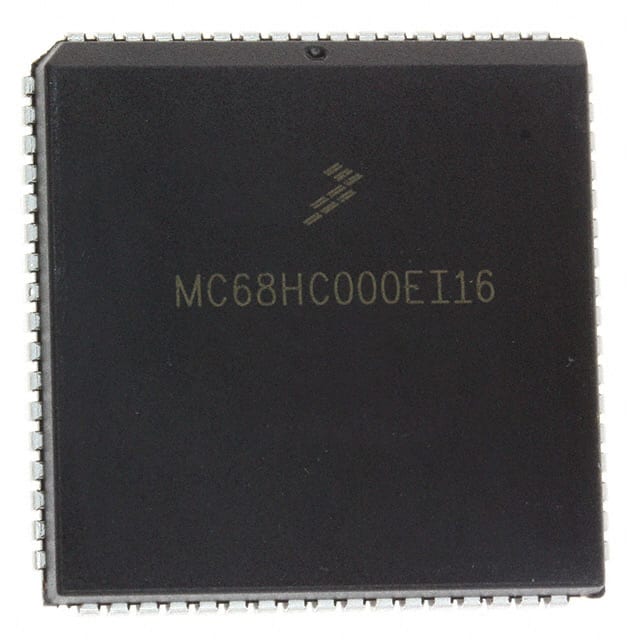Szczegóły produktu można znaleźć w specyfikacjach.

MCHC11F1CFNE2
Basic Information Overview
- Category: Integrated Circuit (IC)
- Use: Microcontroller
- Characteristics: High-performance, low-power consumption
- Package: 64-pin QFP (Quad Flat Package)
- Essence: Central processing unit for embedded systems
- Packaging/Quantity: Individually packaged, quantity varies based on order
Specifications
- Architecture: Harvard
- Bit Width: 8-bit
- Clock Speed: Up to 20 MHz
- Program Memory Size: 32 KB Flash
- Data Memory Size: 2 KB SRAM
- Input/Output Pins: 54
- Timers/Counters: 3
- Communication Interfaces: UART, SPI, I2C
- Operating Voltage: 2.7V - 5.5V
- Operating Temperature Range: -40°C to +85°C
Detailed Pin Configuration
The MCHC11F1CFNE2 has a total of 64 pins. The pin configuration is as follows:
- Pins 1-8: Port A (PA0-PA7)
- Pins 9-16: Port B (PB0-PB7)
- Pins 17-24: Port C (PC0-PC7)
- Pins 25-32: Port D (PD0-PD7)
- Pins 33-40: Port E (PE0-PE7)
- Pins 41-48: Port F (PF0-PF7)
- Pins 49-56: Port G (PG0-PG7)
- Pins 57-64: VSS (Ground) and VDD (Power)
Functional Features
- High-performance 8-bit microcontroller suitable for various applications
- Low-power consumption for energy-efficient operation
- Harvard architecture allows simultaneous instruction fetch and data access
- Ample program and data memory for complex applications
- Multiple communication interfaces for easy integration with other devices
- Built-in timers/counters for precise timing operations
Advantages and Disadvantages
Advantages: - High-performance capabilities enable efficient processing of complex tasks - Low-power consumption extends battery life in portable applications - Ample program and data memory allow for the implementation of feature-rich applications - Multiple communication interfaces facilitate seamless connectivity with external devices - Harvard architecture enhances overall system performance
Disadvantages: - Limited bit width (8-bit) may restrict the execution speed of certain operations - Relatively small package size may limit the number of I/O pins available for larger projects - Higher cost compared to lower-end microcontrollers with similar specifications
Working Principles
The MCHC11F1CFNE2 operates as the central processing unit (CPU) in embedded systems. It follows the Harvard architecture, which allows simultaneous instruction fetch and data access. The microcontroller executes instructions stored in its program memory and manipulates data stored in its data memory. It communicates with other devices through various interfaces such as UART, SPI, and I2C.
Detailed Application Field Plans
The MCHC11F1CFNE2 is widely used in various application fields, including but not limited to:
- Industrial Automation: Control systems, motor drives, and monitoring devices.
- Consumer Electronics: Home appliances, gaming consoles, and audio/video equipment.
- Automotive: Engine control units, dashboard displays, and vehicle diagnostics.
- Internet of Things (IoT): Smart home devices, wearable technology, and sensor networks.
- Medical Devices: Patient monitoring systems, diagnostic equipment, and implantable devices.
Detailed and Complete Alternative Models
- MCHC12F1CFNE2: Similar to MCHC11F1CFNE2 but with a 12-bit architecture.
- MCHC16F1CFNE2: Upgraded version with a 16-bit architecture for higher performance.
- MCHC18F1CFNE2: Enhanced microcontroller with an 18-bit architecture and advanced features.
These alternative models offer varying capabilities and can be considered based on specific project requirements.
Word count: 511
Wymień 10 typowych pytań i odpowiedzi związanych z zastosowaniem MCHC11F1CFNE2 w rozwiązaniach technicznych
Sure! Here are 10 common questions and answers related to the application of MCHC11F1CFNE2 in technical solutions:
Q1: What is MCHC11F1CFNE2? A1: MCHC11F1CFNE2 is a specific model or component used in technical solutions. It could refer to a microcontroller, integrated circuit, or any other electronic component.
Q2: What are the key features of MCHC11F1CFNE2? A2: The key features of MCHC11F1CFNE2 may vary depending on the specific component, but it could include factors like processing speed, memory capacity, input/output capabilities, power consumption, and communication protocols supported.
Q3: What are the typical applications of MCHC11F1CFNE2? A3: MCHC11F1CFNE2 can be used in various technical solutions such as embedded systems, robotics, automation, IoT devices, consumer electronics, and industrial control systems.
Q4: How does MCHC11F1CFNE2 differ from other similar components? A4: The differences between MCHC11F1CFNE2 and other similar components can be based on factors like architecture, performance, compatibility, cost, and availability. It's important to compare specifications and requirements before choosing a specific component.
Q5: Can MCHC11F1CFNE2 be programmed using a specific programming language? A5: The programming language used for MCHC11F1CFNE2 depends on the specific component and its development environment. Common languages for microcontrollers include C, C++, and assembly language.
Q6: Are there any development tools available for MCHC11F1CFNE2? A6: Yes, manufacturers often provide development tools like integrated development environments (IDEs), compilers, debuggers, and programming software specifically designed for working with MCHC11F1CFNE2.
Q7: What is the power supply requirement for MCHC11F1CFNE2? A7: The power supply requirement for MCHC11F1CFNE2 can vary, but it typically operates within a specific voltage range. It's important to refer to the component's datasheet or technical documentation for accurate information.
Q8: Can MCHC11F1CFNE2 communicate with other devices or systems? A8: Yes, MCHC11F1CFNE2 often supports various communication protocols such as UART, SPI, I2C, Ethernet, USB, or wireless technologies like Bluetooth or Wi-Fi, enabling it to communicate with other devices or systems.
Q9: Is MCHC11F1CFNE2 suitable for low-power applications? A9: Depending on its specifications, MCHC11F1CFNE2 can be suitable for low-power applications. Some components offer power-saving features like sleep modes, low-power consumption, or efficient power management.
Q10: Where can I find documentation or support for MCHC11F1CFNE2? A10: Documentation and support for MCHC11F1CFNE2 can usually be found on the manufacturer's website, including datasheets, application notes, user manuals, forums, and technical support channels.

